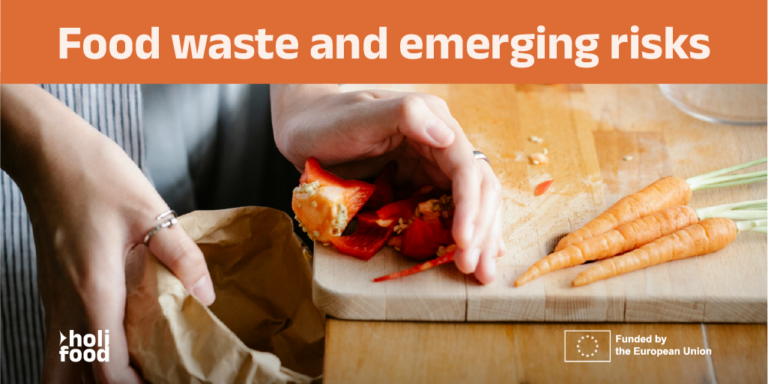Food waste and emerging risks

In recent years, the concept of reusing food waste has gained significant attention as a means of promoting sustainability and reducing environmental impact. This article explores various innovative approaches to repurposing food waste, highlighting its potential as a valuable resource in both human consumption and animal feed.
Re-using food waste – new endeavours and emerging risks
From incorporating spent grains into baked goods to transforming agricultural by-products into nutritious animal feed, these efforts align with circular economy principles and aim to enhance food systems. However, as we delve into these emerging practices, it’s essential to address the associated risks, including microbial contamination and allergen concerns, which underscore the importance of safety and regulatory measures in this evolving landscape.
The listed articles have been detected by Emerging Risk Identification system of University of Veterinary Medicine Budapest, Department of Digital Food Science.
Utilizing food waste as ingredients or additives of food
Spent grain, a by-product of the brewing process, is a nutritionally rich material containing fibres, proteins, lipids, vitamins, and minerals. Its high moisture and nutrient content make it susceptible to microbial contamination, necessitating proper management. By incorporating spent grain into products like bakery items, pasta, cookies, snacks, yogurt, and even beverages, the food industry embraces circular economy principles. This approach not only reduces waste but also aligns with sustainable development goals by recycling materials and energy into new food processes.
Teagasc, the Irish Agriculture and Food Development Authority, is leading a project to extract beneficial compounds such as proteins, fibre, and antioxidants from plant waste. These compounds are used in functional foods that offer health benefits, like reducing the risk of chronic diseases. This initiative promotes sustainable food production by turning waste into value-added products, enhancing both economic and environmental outcomes.
In the realm of marine resources, fortifying foods with omega-3 fatty acids from fish by-products presents opportunities and challenges. These fatty acids, essential for health, are prone to degradation when exposed to air and light. Using antioxidants can help stabilize them, allowing for their successful incorporation into foods. This process not only enhances nutritional value but also utilizes fish parts like skin and bones, which are often discarded or used in low-value products. Addressing concerns about bioaccumulation of heavy metals and additives is crucial for food safety, prompting the need for further research and improved extraction methods.
Natural pigments derived from food waste, such as anthocyanins and betalains, provide safe and vibrant color options for food products. These pigments have antioxidant properties and can improve the nutritional and visual appeal of foods. However, their stability in different pH ranges and economic extraction processes remain challenges. Utilizing plant waste as a source for these natural colorants aligns with circular economy principles, making the extraction processes more affordable and sustainable.
Researchers are also exploring the transformation of agricultural waste into lipids for plant-based meat alternatives. By converting waste into gas and then producing lipids through microbial fermentation, discarded crop parts like corn husks can be repurposed. This method not only supports the production of meat alternatives but also reduces methane emissions, which have a significant environmental impact.
In another innovative approach, studies on peanut skins reveal their potential as animal feed. Rich in proteins, carbohydrates, fats, fibre, minerals, and vitamins, peanut skins also contain bioactive compounds with antioxidant properties. Research into their use in poultry diets indicates nutritional benefits and potential food safety improvements by reducing salmonella bacteria. Despite concerns about peanut allergies, no allergenic proteins were detected in products from birds fed peanut-containing diets.
Utilizing food waste in the feed industry
A study outlines an innovative approach to transform by-products from the orange juice industry into high-quality animal feed. The strategy involves a two-step process: saccharification of orange peels and aerobic fermentation of the liquid residue. These processes were optimized using factorial design to ensure maximum efficiency and effectiveness. The resulting animal feed is formulated by combining the solid residue of saccharified orange peels with yeast cultivated on orange peel hydrolysate. This mixture is then dried to stabilize the product. The final feedstuff demonstrated a 23.11% increase in in vitro organic matter digestibility and tripled protein content, offering a promising solution for valorising waste and producing nutritious animal feed.
UK’s Food Standards Agency has initiated a research project to explore the use of food waste and other substrates for insect bioconversion. This project aims to evaluate the safety and suitability of diverse feedstocks for rearing insects, potentially expanding the scale of insect use in the feed industry. The University of Surrey will investigate the risk of allergen transfer, while Fera Science will focus on rearing selected insect species on various substrates to assess potential chemical and microbiological contaminants. These may include heavy metals, veterinary medicines, pesticides, and persistent organic pollutants like dioxins and mycotoxins. Industry partners, such as Better Origin and Entec Nutrition, are engaged to ensure the research aligns with practical needs. The findings will inform the FSA’s policymaking and guidance on animal feed safety and hygiene. A comprehensive report is expected in 2023 and will be available publicly as an Open Access article.
These diverse initiatives underscore the potential of food waste to contribute to sustainable, functional food systems. By transforming waste into valuable ingredients, the food industry can enhance sustainability, improve nutritional quality, and meet consumer demands for natural and environmentally friendly products.
However, there are certain risks, that may accompany these endeavours such as microbial, chemical risks, risk of allergenicity especially until regulatory aspects – traceability, labelling, compliance etc. are not clearly elaborated.
Dumpster living
Dumpster living, the practice of retrieving food from waste, is gaining traction not just among those facing financial difficulties but also among sustainability advocates. An article highlights the causes of food waste, such as items spoiling at home, approaching expiration dates, and unsellable produce. It stresses the importance of education and easier processes to mitigate waste and suggests practical tips like using vegetable trimmings for stock.
Legislative efforts are also emerging, particularly in Germany, where ministers are supporting a proposal to allow people to collect food from supermarket trash without legal repercussions, as long as there is no trespassing. The food industry opposes this, arguing that existing laws already allow for the non-prosecution of trivial cases. Germany produces 11 million tons of food waste annually, and the government aims to halve this by 2030, promoting donations to food banks. In Italy, companies receive financial incentives under the “Good Samaritan Law” for preventing food waste.



